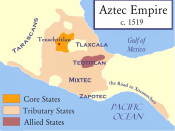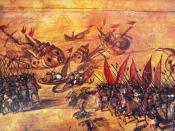Spanish explorers coming to the new world in the 16th century were astounded with the amazing architecture built by by the Aztecs, who lacked European technology. European technological advances such as tools of hard metal and wheeled vehicles.
Hernan Cortes, a minor Spanish nobleman conquistador, wrote in the second of five reports to Emperor Charles V a description of the Aztec capital city Tenochtitlan, "considering that this is a barbarous nation shut off from a knowledge of the true God or communication with enlightened nations, one may well marvel at the orderliness and good government which is everywhere maintained". By this passage, you can tell that Hernan Cortes and the Spanish were surprised by that the Aztecs lived so prevalently while lacking a "true God".
Yet from the Spanish conquest of Bernardino de Sahagun's Florentine Codex, you can assert that the natives placed a significant importance on religion.
The Aztecs centraization was much like the Spanish, both were grounded in religious concepts.
When the Spaniards first arrived, the Aztecs did not take them as a threat. It is said that the Aztec Monarch Moctezuma (often called Montezuma), of the city Tenochtitlan, believed that Hernan Cortes was an ambassador of the Aztec God Quetzalcoatl, who disappeared centuries ago and promised to return. This was vital mistake, in that the Aztecs refrained to acclimate a new understanding and instead explained the unfamiliar with the familiar.
As the Spaniards began to conquer the Aztec cities, it was not their superior firearms, cannons, or military strategy that eliminated the Aztec warriors (thought it didn't hurt either), but pestilence known as smallpox. The Aztecs had no natural immunities to European diseases, which led to many Aztec deaths.
In the early 1520's the Aztec Empire was no more. The buildings, pyramids, temples, and...


